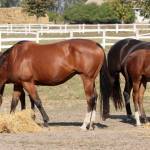Social Behavior Among Horses at Feeding Time

Horses are extremely social animals. When grouped in a herd, they arrange themselves in a well-defined social hierarchy, usually based on sex and age. As horses are added or removed from the herd, the pecking order typically shifts. Careful observation of interactions among horses reveals a slew of dominant and submissive behaviors. When it comes to feeding, these behaviors are in full show.
Luckily, there are ways to keep the peace during feeding time. The most effective method is probably thoughtful arrangement of feeders. Whether they are hung from a fence or placed on the ground, feeders should be set at least 50 feet apart. At this distance, it is nearly impossible for a dominant horse to control more than one feeder. Setting them significantly closer, which is convenient for those feeding and therefore a common practice, leads to a dominant animal that rushes frantically back and forth in an attempt to control both feeders.
When feeders are placed too close together, horses may learn to eat hurriedly. Horses that dive aggressively into their feed and swallow large quantities at once are said to “bolt” their feed. These horses might not get the most out of their meals, as sometimes feed is swallowed without being chewed properly. Bolting may also predispose a horse to choke, a potentially dangerous condition in which food becomes lodged in the esophagus.
In a study conducted at the University of Kentucky, researchers measured the time it took for dominant and submissive horses to eat an identical quantity of sweet feed, about two and a half pounds, out of feed tubs placed in a straight line or arranged in an equilateral triangle. Four groups of three mature horses were videotaped while they ate so behavior could be monitored closely. Dominant horses completed the meal in an average of 8.04 minutes.
Submissive horses, on the contrary, cleaned up their feed in 6.13 minutes, suggesting aggressive horses were considerably more casual about polishing off meals.
The research also indicated that passive horses had more time to eat when feed tubs were placed in an equilateral triangle compared to a straight line. Researchers believe arrangement in the triangle might optimize visual contact with other horses, more closely resembling the normal grazing behavior of pastured horses.
In a closed herd where animals are rarely added or removed, horses become quite familiar with the routine of feeding. While most remain intensely aware and respectful of the pecking order, out-and-out fighting rarely occurs.








